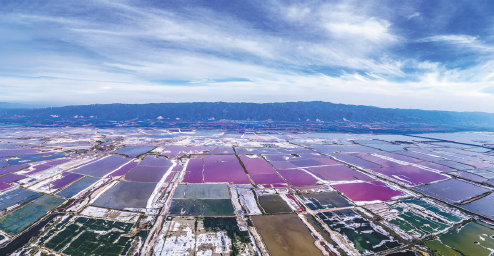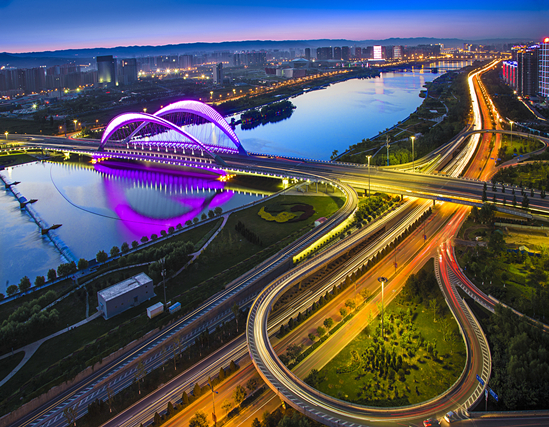Eco efforts bring new revenue streams to lake
Updated: 2023-06-09

Salt Lake becomes colorful in the early summer, making it an attraction for tourists and photographers. [Photo by Yan Xin for China Daily]
Environmental work has attracted back wildlife and tourists
Salt Lake in Yuncheng has been the most precious natural asset of this southern Shanxi city throughout its history of thousands of years and it continues to bring benefits to people.
The significance of this lake is a result of the millennia-long development of the salt mining industry.
As an indispensable substance for humans, salt exists in the form of sodium ions, maintaining water and electrolyte balance in the human body.
It is said that the salt mining industry was one of the crucial driving forces for human civilization. This was especially true in regions like Yuncheng, which is far from the ocean and where salt production requires more difficult techniques than simply drying seawater.
According to the current archaeological evidence and historical records, as early as the Neolithic Age more than 7,000 years ago, there were human communities existing around Salt Lake in Yuncheng.
In legends, there was a major battle between the tribes of the Yellow Emperor and Ci You some 5,000 years ago, vying for the control of the Salt Lake. The Yellow Emperor's tribe won, leading to the formation of a nation that gradually grew into today's China.
Since the Qin (221-206 BC) and Han (206 BC-AD 220) dynasties, the salt mining industry in Yuncheng had developed into a major source of the nation's fiscal revenue. Historical documents show that taxes collected from Yuncheng's salt production accounted for about one-eighth of the national fiscal revenue during certain periods of the Tang Dynasty (618-907).
After the founding of the People's Republic of China, Yuncheng's salt industry continued to grow and diversify. Salt Lake once became the largest mineral salt production base in the nation several decades ago.
However, salt mining on the lake was brought to a halt in 2020, for the purpose of restoring and protecting the ecological environment according to the requirements of China's central authorities.
When production reached its peak decades ago, the local ecological environment was severely challenged, according to Diao Haipeng, vice-mayor of Yuncheng.
"These environmental challenges included damage to embankments, a decrease of vegetation along the lake and silting-up of water courses," Diao said. "After millennia of prosperous growth, the lake needs to slow down its pace of development and have respite."
The city of Yuncheng called a halt to salt-related production in September 2020 and began an environmental improvement program for the lake in 2021, according to the official.
He said that the program included dredging the entire lake and its connected watercourses, enhancing 98 kilometers of embankments and planting a vegetation belt along the lake.
After two years of efforts, Salt Lake has seen a steady improvement in its environment.
"The lake is now a better habitat for birds and other wildlife," said Sun Dongqing, head of the environmental protection and development center for Salt Lake.
He added that a total of 205 bird species have been recorded over the two years, including such rare varieties as flamingo, swan, pied avocet and great bustard.
The flamingo is an endangered species of stork mainly living in Africa, Central Asia and South Asia. Records show that the birds were first discovered in China in the late 1990s. And now the city of Yuncheng has become a favored winter habitat by the bird.
Sun added that the wetlands along the lake are home to more than 30 varieties of plants unique to the saline and alkaline environment.
The water of the lake is supplied by streams originating from the neighboring Zhongtiao Mountains. The Zhongtiao area is another target of environmental improvement, according to Vice-Mayor Diao.
"The mineral-rich Zhongtiao streams are the lifelines for the lake," Diao said. "Through increasing vegetation coverage and economized use of water among residents and businesses, the streams' runoff into the lake has been increasing steadily over recent years."
He added that the streams' annual supply of saline minerals to the lake has now reached 200,000 metric tons, among the best levels in history.
When salt production temporarily closed at the lake, Diao said how to ensure revenue was a concern among residents, businesses and officials.
The official noted that production will be back when the improvement program is completed, but in a rational scale aiming to strike a balance between environmental protection and economic growth.
He said additional revenues will come from industries derived from salt production.
"In the past decades, we produced salt for industrial use," Diao said. "But now we are diversifying into the fine chemicals sector, producing products for healthcare and the farming industry."
One example is the development of products based on black mud from the lake bed.
Black mud is a resource unique to Salt Lake. Containing fulvic acid and 38 varieties of minerals, the black mud is used for making products for healthcare, skin care and crop care.
Salt Lake is becoming an emerging tourist destination in Shanxi province, which has developed into another major stream of revenue.
"On this lake known as the Chinese version of the Dead Sea, floating on the water's surface is an unforgettable experience that you can never find elsewhere in the country," said a tourist on his WeChat account.
In recent years, the lake once again became a hit on social media because of eye-catching aerial photos of its colorful surface.
As temperatures begin to rise in early summer, the multicolored Salt Lake becomes a bustling attraction for tourists and photographers.
Scientists attribute the rich colors of the lake to the propagation and growth of halophilic algae and brine shrimp. The organisms change color at various temperatures, turning the lake into a huge painter's palette.
Li Ningbo contributed to this story.



